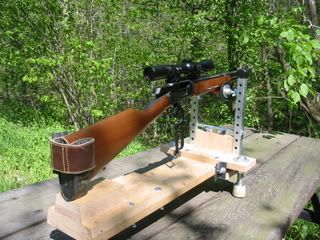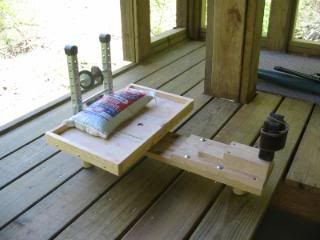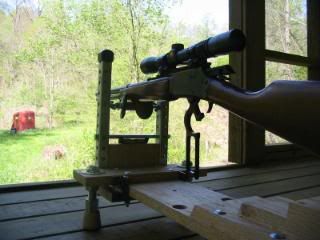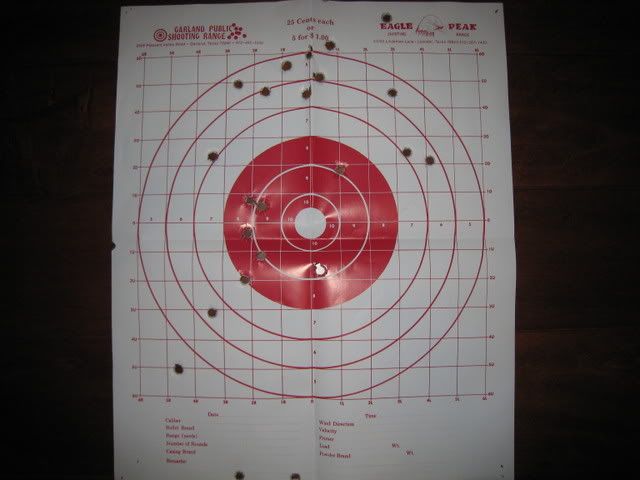bogus bill wrote:Helps to have the wife to run back and forth to the target.
...actually, a
kid works even better - you can reward them by letting
them shoot...!

Some other thoughts
1. Don't get discouraged - most of us would have to use wide-angle lenses to photograph the first dozen 'groups' we shot.

2. Get a good rest - my 12 year old and I made this one in a few hours with scrap wood and $50 of parts from the hardware store, or you can buy them pretty cheap. With a really good rest off a good solid bench (or on the ground if no bench available) the only 'variable' besides the gun and ammunition is your trigger pulling. You will likely get much better groups off the rest, and if you
don't, then take heart - the problem is likely partly with the gun or ammo. Once you get sighted in and so on, then you can wean off the fancy rest and just use a sandbag, old coat, or dead cat

.



Note - the reason we BUILT rather than bought the rest, was it is really nice to have one with clearance working the lever on a levergun (or using an EBR with a "protruding vertical grip" or "high capacity magazine"

)
3. The rear sights always moves towards the way you want to move the bullet.
4. If there are marks on a sight, once you get a group, move say ten or twelve marks, then re-shoot. It is easier to calculate what a "mark" is on that gun that way, then go 'back' some if needed. For instance if 12 marks moves the bullet 4" to the left, then you know each mark is about 1/3 of an inch. If you had just adjusted say two clicks, and the group had moved about 1/2 to 1 inch (good luck detecting the difference between those) you'd still not know whether eight clicks would move you two inches or four inches.
5. If there are NO marks on the sights, and you can use a fine pencil or scribe to make some, that can help (four 'light taps' doesn't always move the sight twice as much as 'two light taps').
6. I use old cardboard boxes with magic-marker 'dots' at 15 yards at first to be sure I'm "on paper" - bore-sighting the old fashioned way if needed. Then real targets at 25, 50, 75, then 100 yards - usually a 'bullseye' at 25 yards will be at least close at 75 yards, but not always.
7. Sighting in a SCOPE is usually
way easier than adjusting open sights of most types, so. . . When I want to either test a gun/load for the 'ultimate' accuracy, or get sighted in with confidence, if the gun can mount a scope, I mount my cheap BSA
36x scope, and shoot off a rest/bench. That way I can see the target in great detail at 100 yards and not do all the running back and forth or need a spotting scope, and I can be SURE that when I miss the bullseye, it is NOT because I couldn't see well enough, or 'pulled' the shot (the scope would give that away). Then I know what the gun CAN do, and I'll decide what other sight (scope, peep, tang, etc.) I will want on it based on the gun's potential, my planned use of it, and sometimes, purely appearance or historical appropriateness.
8. With some mounts (i.e. the 'side mounts' for Winchesters or the see-through mounts for Marlins) you can leave that scope on and with the gun in the rest, adjust the sights until looking through them shows you the same thing that looking through the scope does. Then you KNOW where your bullets have already 'hit' (because you can see the holes through your scope) with the sight picture you have. Remove the scope, and fire some confirming shots, and your shots will likely be right where you want them without as much hassle as if you hadn't done all the 'adjusting' steps while looking through a scope.
9. Sometimes a loose sight, forend ("I'd swear I just tightened those things!"), or scope can mess you up big time, so always check them all.
10. Even if you don't need a 'runner' - take a friend, kid, wife, or co-worker. If you think they'll be bored while you piddle around with sighting-in, bring along a .22 or something they can shoot cans with while there. That helps recruit new shooters to the hobby.





